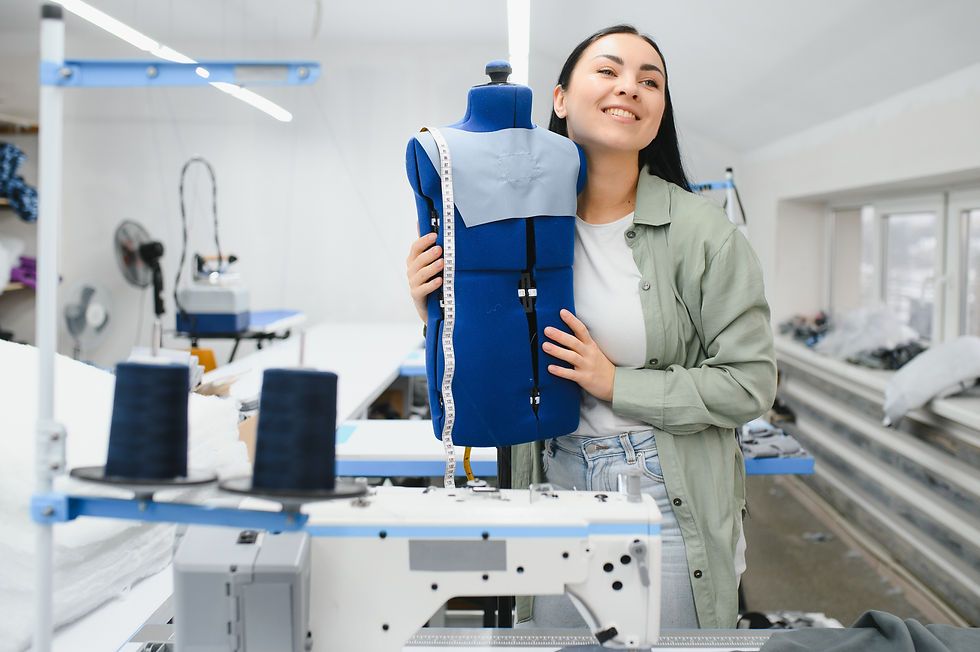Summer Fabric Trends 2025: What Fashion Brands Need to Know
- Büşra Dalman

- Jun 13
- 3 min read
Updated: Jun 17

As summer 2025 approaches, fabric choices are more important than ever for designers aiming to stay relevant and responsible. From tactile aesthetics to low-impact materials, summer fabric trends 2025 reflect a convergence of sustainability, comfort, and sophisticated texture. For emerging fashion brands, understanding this landscape is key to building collections that are both market-ready and future-proof.
A Textural and Tonal Shift in Summer Fabrics
Summer 2025 embraces a richer aesthetic. Rather than flat minimalism, the season celebrates materiality:
3D surfaces: Think plissé, smocking, puckered weaves, and jacquards
Transparencies: Layers of tulle, organza, and mesh in romantic cuts
Subtle shine: Sateen, iridescent finishes, and laminated cottons make a return
Earth-toned palettes: Mocha mousse, toffee, clay orange, butter yellow, and ice blue
Texture isn't just a design feature—it's now part of how brands express mood, sustainability, and tactile intimacy.
Most Popular Fabrics in Summer Fabric Trends 2025
1. Cotton (Organic & BCI)
Still the backbone of summer fashion, cotton is now often organic or certified by Better Cotton Initiative (BCI). Brands use:
Pima and combed cottons for softness
Lightweight cotton poplins and voiles for airflow
Sustainable cotton blends for commercial basics
2. Linen and Linen Blends
Linen's crisp texture and breathability keep it a summer hero. New blends improve handfeel and reduce wrinkling:
Linen-cotton: For softer, less wrinkle-prone weaves
Linen-viscose: Adds drape and dye vibrancy
EUROPEAN FLAX® certified linen: A sustainability benchmark
3. TENCEL™ Lyocell
Soft, durable, and moisture-wicking, TENCEL™ offers:
Closed-loop production process
Drapey textures for relaxed tailoring and dresses
Enhanced dye absorption
4. Viscose / EcoVero™
A regenerated cellulosic fiber, viscose in its EcoVero form is trending for:
Flowing silhouettes in dresses and skirts
Soft touch similar to silk
Sustainable sourcing and traceability
5. Recycled Polyester (rPET)
Used in activewear, swimwear, and linings, rPET offers:
Fast-drying performance
Strong wicking ability
Derived from post-consumer plastic bottles
6. Hemp and Cottonized Hemp
With its low water usage and high durability, hemp is gaining fashion momentum:
Natural antibacterial properties
Used in lightweight denim and shirting
Often blended with cotton or lyocell for softness
Technical Properties Fashion Brands Should Prioritize
To stand out in 2025, fabrics must do more than look good. Here are the key qualities driving material choices:
Breathability
Top performers: Linen, Tencel, cotton gauze, hemp
Low-density weaves: Improve airflow and comfort
Moisture Management
Wicking fibers: rPET, Tencel, fine Merino
Blends: Designed to balance absorbency and evaporation
Stretch and Movement
Elastane blends: Up to 5% for structure without sacrificing comfort
4-way stretch fabrics: In swim and sport collections
Weight and Drape
Ultra-light weaves: Voile, mesh, seersucker
Structured lightweights: Cotton-linen suiting, puckered blends
Sustainable Innovation in Summer Fabric Trends 2025
Waterless and Low-Waste Dyeing
Dope-dyeing: Integrates pigment before spinning
CO2 dyeing: Replaces water with pressurized carbon dioxide
Botanical dyes: For capsule collections
Regenerative and Certified Fibers
Organic cotton & regenerative hemp
RWS-certified wool, ZQ Merino, and GOTS textiles
Circularity and Recycling
GRS-certified rPET and recycled cotton
Mono-material garments: For easy post-use recycling
Upcycling initiatives: Scrap-based woven or patchworked fabrics
Real-World Examples: How Major Brands Are Using Trend Fabrics
Chloé SS25: Used botanical-dyed cotton voile and TENCEL™-linen blends in earth tones
Gabriela Hearst: Developed denim-like fabric from upcycled cotton and flax
Stella McCartney: Integrated Mylo™ (mushroom leather) and lab-grown silk in accessories
Patagonia: Deployed NetPlus® (fishing net nylon) and organic hemp in trailwear
H&M Conscious: Focused on Tencel, EcoVero, and rPET swimwear with traceability tags
A Material Message for Fashion Startups
In 2025, fabrics are more than a backdrop—they are the message. The strongest collections will combine breathable performance, rich texture, and sustainability. By tapping into summer fabric trends 2025, emerging brands can build pieces that resonate with modern consumers while standing out in a competitive market.
Looking to source on-trend fabrics for your 2025 collection? Start with natural, breathable, and circular options aligned with summer fabric trends 2025.
Let’s Talk
Read through this guide and wondering which fabrics are best suited for your summer 2025 collection—or how to turn trend inspiration into a production-ready plan?
At Ayder Textile, we work directly with fashion startups and emerging labels to simplify sourcing, sampling, and manufacturing. Whether you're choosing between linen blends or exploring low-MOQ options for your launch, we’re here to help.
From trend-matched fabric recommendations to ethical material sourcing and pre-production consulting, our team makes sure you move forward with clarity.
📩 Reach out to explore how we can support your journey. We’re happy to suggest fabrics, review your production roadmap, or answer any questions about sustainable manufacturing in Turkey.
Büşra Dalman
Author of the Article / Customer Representative
Ayder Textile
📞 +90 212 550 74 40
📍 No: 17, Şehit Hidayet Yılmaz Street, Fevzi Çakmak Avenue, 15 Temmuz Neighborhood, Bağcılar, Istanbul 34212, Turkey



Comments